Teaching your dog to walk politely beside you, known as “walking to heel,” is one of the most fundamental and rewarding aspects of dog training. For many dog owners, a daily walk can quickly become a frustrating tug-of-war, with their beloved companion pulling incessantly on the leash. This common issue not only makes walks unpleasant but can also pose safety risks for both the dog and owner. At Dog Care Story, we understand the challenges and are committed to providing effective, humane solutions to help you achieve harmonious walks. This guide will delve into the underlying reasons why dogs pull on the lead and, more importantly, equip you with the knowledge and techniques required to master basic command training for dogs, focusing on the essential skill of How To Teach Your Dog To Walk To Heel, transforming your outings from stressful struggles into enjoyable strolls. Whether you’re dealing with an enthusiastic puppy or an adult dog with ingrained habits, our expert-backed approach aims to foster a stronger bond and better leash manners.
Understanding Why Your Dog Pulls (The Root of the Problem)
Before you can effectively teach your dog to walk to heel, it’s crucial to understand the motivations behind their pulling behavior. Dogs don’t pull out of malice; they pull because, from their perspective, it often works. Identifying the specific reason for your dog’s pulling is the first step towards a lasting solution.
Anticipation
This is a common reason, especially for dogs that are usually well-behaved on the return journey. If your dog gets overly excited on the way to the park, a favorite sniffing spot, or to meet another dog, they are likely pulling due to anticipation. They’re eager to get to their destination, and the faster they pull, the faster they believe they’ll get there. This type of pulling often dissipates on the way back when the excitement has worn off, highlighting a clear pattern of eagerness-driven behavior.
Control
Some dogs pull because they have an innate desire to control their environment and the pace of the walk. These “control freaks” typically pull consistently throughout the entire walk, both to and from the park. They want to dictate where you go, how fast you walk, and what they get to investigate. This behavior stems from a perceived leadership role, where they believe they are guiding the walk rather than following your lead. This often requires a clear re-establishment of boundaries and who is in charge of the walk.
Fear
Fear can manifest as pulling, particularly if your dog only pulls on the way back home. This type of pulling is driven by a strong desire to return to the perceived safety and security of the house. Dogs might be fearful of traffic noise, unfamiliar people, other dogs, or even wide-open spaces (agoraphobia). A negative association with the lead itself can also contribute to this fear-driven pulling. For these dogs, addressing the underlying fear is as important as the heel training itself. This might involve desensitization, counter-conditioning, and creating a positive association with walks and the outdoors.
The Physics of Leash Pulling: Why Traditional Methods Often Fail
Many owners inadvertently reinforce pulling due to a misunderstanding of basic physics. Sir Isaac Newton’s Third Law of Motion states that for every action, there is an equal and opposite reaction. This fundamental principle applies directly to the dynamic between you and your dog on a leash.
When your dog pulls forward, and you instinctively pull back on the leash, you are creating an opposing force. This “action-reaction” loop means your dog effectively “pushes” against your “pull,” making them feel like they need to pull even harder to overcome your resistance. This immutable law of physics explains why short, standard leashes can often contribute to pulling problems. It’s a constant battle where both parties are working against each other.
It’s often observed that dogs walk perfectly well off-leash but become a nightmare once the leash is clipped on. This stark difference highlights how the leash itself, and the way it’s used, can trigger or exacerbate pulling. Furthermore, retractable leads are particularly problematic. By constantly providing tension and allowing the dog to move far ahead, these leads inadvertently teach a dog that pulling is the expected behavior, effectively telling them to pull every time they are used. They offer no consistent feedback for loose-leash walking and can even be dangerous due to the sudden jerking motion and lack of control.
The Dog Care Story Approach: Tools for Effective Heel Training
At Dog Care Story, we advocate for training methods that work with your dog’s natural instincts, focusing on communication and positive reinforcement, rather than pain or discomfort. Our unique system, developed through extensive experience, centers around specific tools and techniques to help you teach your dog to walk to heel effectively.
Introducing the Jingler: A Tool for Focus and Communication
The Jingler is a simple, yet profoundly effective training aid designed to use sound therapy to help your dog concentrate and understand boundaries. Unlike a clicker, which marks desired behaviors, the Jingler provides a subtle, non-aversive sound that indicates when your dog has made a mistake, redirecting their focus back to you. It’s a clear, consistent signal that helps your dog differentiate between right and wrong actions during training. This crucial feedback mechanism helps your dog learn what is expected of them without relying on harsh corrections. We also have resources on how to get your puppy to walk which can be helpful if you’re starting with a young dog.
To properly utilize the Jingler, you will first need to teach your dog the “OFF” command. This command trains your dog to turn its head away from an offered treat if not given permission, establishing a foundational understanding of impulse control and responsiveness to your cues. The Jingler is designed to attach to the end of the lead, near the collar, and works in conjunction with our specialized leads and collars.
The Importance of a Quality Lead and Collar
The right equipment is paramount for successful heel training. We’ve developed our own leads and collars specifically tailored for our techniques. Our leads are 5 feet 8 inches long, made from cushion web for incredible comfort and strength. This specific length is crucial for providing the right balance of freedom and control, allowing for effective communication without the constant tension of shorter leads or the detrimental effects of retractable ones.
Our leads feature a D-Ring for attaching the Jingler and an O-ring at the handle end, which is convenient for carrying waste bags, securing the lead around your shoulder when your dog is off-leash, or halving the lead’s size in busy areas. The materials, clips, and rings are all sourced and manufactured in the UK, ensuring quality and durability.
Alongside the lead, a quality, reasonably wide collar is essential. Our collars are made from a similar comfortable and strong material as our leads. Avoid thin or rolled collars, as these can dig into your dog’s neck, causing discomfort and potential damage. A proper collar provides a comfortable point of contact for the lead and the Jingler. For more guidance, you can refer to our article on how to get puppy to go on walks to ensure a positive start to leash training.
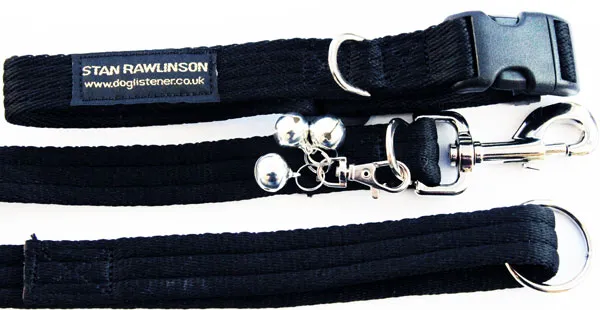 The Dog Care Story custom-designed lead, collar, and Jingler device for effective dog training
The Dog Care Story custom-designed lead, collar, and Jingler device for effective dog training
Why We Avoid Harnesses, Halti’s, and Other Restraint Devices
At Dog Care Story, we firmly believe that true training should not rely on pain, discomfort, or inhibition. This is why we strongly advise against the use of devices like harnesses, Halti’s, choke chains, or check chains. These contraptions do not train a dog to walk to heel; they merely inhibit pulling through discomfort, and can even cause long-term physical and mental harm. Our method, in contrast, teaches correct heelwork without inflicting pain.
The Illusion of “Training Aids”
Many of these devices are marketed as “training aids,” but if a device only works by hurting your dog and the pulling immediately resumes once it’s removed, it hasn’t trained anything. It has simply hindered the dog’s ability to pull by creating an unpleasant sensation. A truly effective training aid should facilitate learning, not inflict discomfort.
Let’s examine how some of these devices function:
- Halti’s and Head Restraints: These devices work by pulling the dog’s head down towards their chest when they pull forward. Try pulling your own chin to your chest – it restricts breathing and feels uncomfortable. They also tighten around the most sensitive part of a dog’s muzzle, causing pain.
- Harnesses: Many harnesses compress the chest and lungs, and tighten uncomfortably under the armpits of the front legs, pinching sensitive skin. They can also alter a dog’s natural center of balance, causing them to be pulled slightly sideways.
- Choke and Check Chains: These are barbaric methods that inflict pain and can cause serious physical damage to the dog’s trachea, larynx, and cervical spine, in addition to psychological distress. We absolutely condemn their use.
If a trainer or behaviorist recommends a Halti or a harness, it’s worth questioning their understanding of canine behavior and humane training principles. A truly professional and effective trainer will teach you methods that foster cooperation and understanding, not rely on pain.
 Dog wearing both a restrictive harness and a Halti head collar, often causing discomfort
Dog wearing both a restrictive harness and a Halti head collar, often causing discomfort
Step-by-Step Guide: Teaching Your Dog to Walk to Heel
With the right tools and understanding, teaching your dog to walk to heel becomes a straightforward, positive experience. This method focuses on clear communication and consistent reinforcement to build good habits.
Prerequisites
- Suitable Equipment: Ensure you have a lead that is at least 5 feet 8 inches long, a quality collar, and the Jingler.
- “OFF” Command Mastered: Your dog should consistently respond to the “OFF” command to establish a foundation of impulse control.
The Heel Training Technique
- Starting Position: Your dog should always be on your left-hand side. This consistent positioning is crucial for clear communication.
- Lead Holding Technique: Hold the lead in your right hand. Loop the end of the lead over your thumb and close your palm over the loop for a secure grip.
- Left Hand Placement: With your left hand, hold the lead between 8 to 20 inches up from your dog’s collar, adjusting the distance based on your dog’s height. This provides immediate control and feedback.
- The First Step and Command: Step off with your left foot, simultaneously saying the command “Heel.” It’s vital to pair the command with the correct action from the very beginning.
Most people make the mistake of saying “Heel” when their dog is already out of position (either in front or behind). This inadvertently teaches the dog the wrong association with the command. The key is to initiate the command as you begin to move, ensuring your dog understands that “Heel” means to walk alongside you, by your left leg.
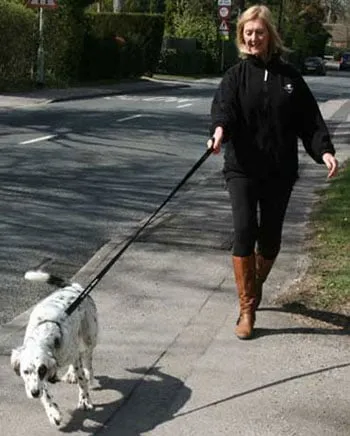 Dog struggling and pulling hard on its leash during a walk
Dog struggling and pulling hard on its leash during a walk
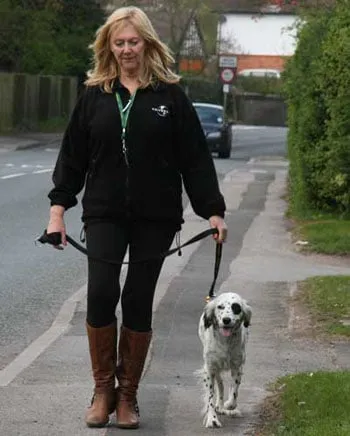 Well-behaved dog walking calmly to heel beside its owner after effective training
Well-behaved dog walking calmly to heel beside its owner after effective training
Consistency and Repetition
Consistency is paramount. You may need to remind your dog using this technique over the next few weeks, but you should notice an almost immediate improvement in your walks. The Jingler provides the immediate feedback needed to help your dog learn rapidly. By consistently applying these steps, you reinforce the desired behavior, leading to a dog that walks happily and politely by your side. With practice, you should be able to achieve excellent heelwork with or without the lead, and eventually without the Jingler when on the lead, demonstrating true mastery of loose-leash walking. This also sets a great foundation if you ever want to how to train my dog to walk off leash.
Advanced Heel Work and Overcoming Challenges
While the basic steps provide a strong foundation, some dogs may require more visual guidance or encounter specific challenges. For those who prefer a step-by-step visual instruction or are struggling with certain aspects of the technique, our instructional DVD is highly recommended. It meticulously breaks down the entire process into easily followed visual instructions and prompts, making complex concepts simple to grasp.
Our comprehensive DVD also covers other crucial behaviors, including jumping, the sit-stay (which is the foundation for a reliable recall), and the “OFF” command. Mastering these commands transforms your dog’s perception of you, fostering a happier, better-behaved pet. Many owners find that after experiencing the effectiveness of the Jingler, they seek out the visual instructions to maximize their training success. The DVD is available in both streaming and disk formats, offering flexibility and convenience.
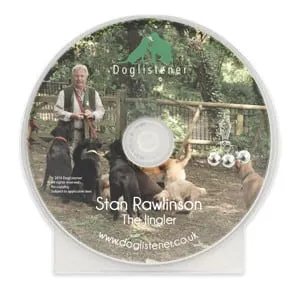 Instructional DVD cover for the Jingler training method, showing dog heel work
Instructional DVD cover for the Jingler training method, showing dog heel work
Real-Life Success Stories
The effectiveness of our training methods and the Jingler system is best illustrated by the numerous success stories from grateful dog owners:
- Dee Sedgwick with Harley: Dee reported an “amazing transformation” in her dog Harley’s walks, particularly on routes where he previously pulled excessively. She noted excellent walking both to and from the beach after just a short time using the Jingler.
- Lina: Lina shared her disbelief at the “change we’ve seen in our dog since we started doing your Jingler training two weeks ago. I can finally walk him!” She also inquired about recall training, a testament to the system’s effectiveness.
- Gillian with Darcey: Gillian purchased the DVD, lead, collar, and Jingler, and found that her dog Darcey “walks beautifully on her lead. I only clipped the bells on and hey presto! Amazing is the only way I can describe it.”
- Royston Jones: Royston described the Jingler and training methods as “fantastic,” observing that his 5-year-old Labrador cross “was responding to walking to ‘heel,’ whereas she would normally be pulling hard when out walking.” Within two days, his dog was happily walking at heel even off-lead.
- Maxine with Douglas: After two years of struggling to teach Douglas to heel, Maxine found that with the Jingler, Douglas walked “beautifully by my leg the whole time” and even managed to walk past other dogs without pulling.
These testimonials highlight the rapid and profound impact our methods have on dogs and their owners, demonstrating real-world expertise and successful experiences in teaching dogs to walk to heel.
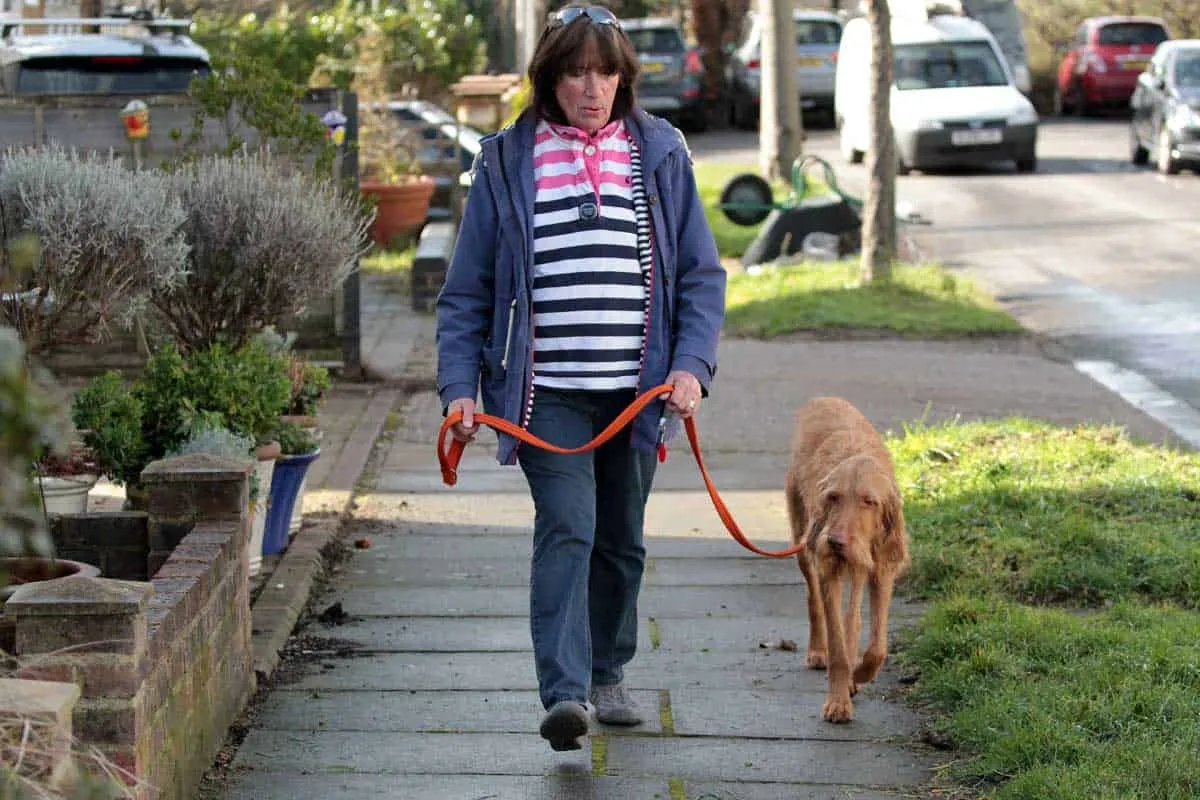 Happy dog owner Dee Sedgwick with her well-behaved dog Harley, trained using the Jingler
Happy dog owner Dee Sedgwick with her well-behaved dog Harley, trained using the Jingler
Conclusion
Mastering how to teach your dog to walk to heel is not just about obedience; it’s about fostering a deeper connection and making every walk an enjoyable experience for both you and your canine companion. By understanding the reasons behind pulling, rejecting harsh methods, and embracing effective, humane training tools like the Jingler, you can achieve harmonious walks. Our approach emphasizes clear communication, consistent boundaries, and positive reinforcement, transforming your dog into a well-behaved walking partner.
We encourage you to explore our specialized Jingler, leads, and collars, and consider our instructional DVD for visual, step-by-step guidance. With commitment and the right techniques, you can overcome pulling and enjoy the pleasant, controlled walks you’ve always desired.
References
- The Jingler: (Product Link for Jingler)
- The Alpha Myth: https://doglistener.co.uk/alpha/thealphamyth.shtml
- Killing With Kindness: https://doglistener.co.uk/alpha/killing_with_kindness.shtml
- Instructional DVD: https://doglistener.co.uk/dvd-shtml/
- Recall Training Article: https://doglistener.co.uk/behavioural/recall_training.shtml
- Choosing the Right Lead and Collar: https://doglistener.co.uk/importance-right-dog-lead/
- Why Some Dog Treats Can Be Dangerous: https://doglistener.co.uk/why-some-dog-treats-can-cause-concerns
